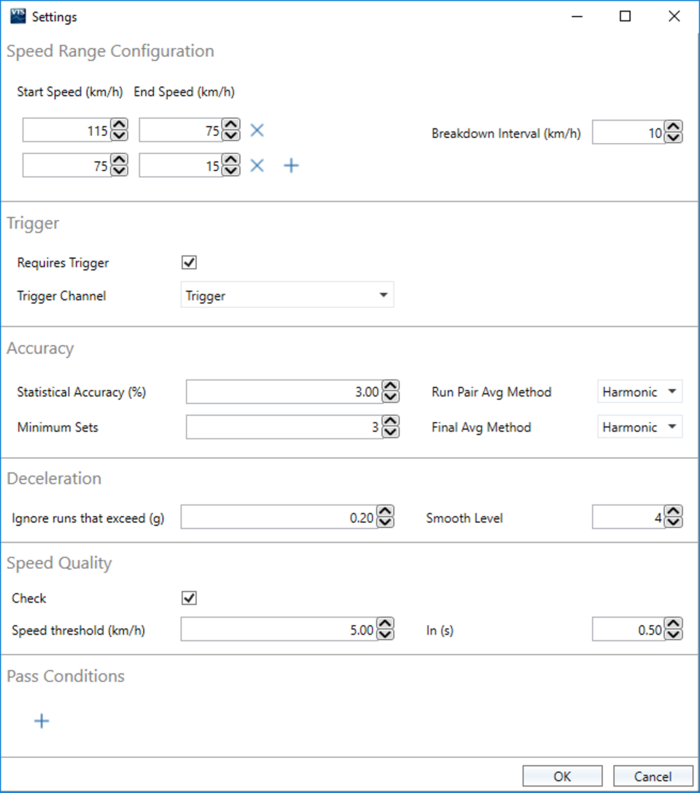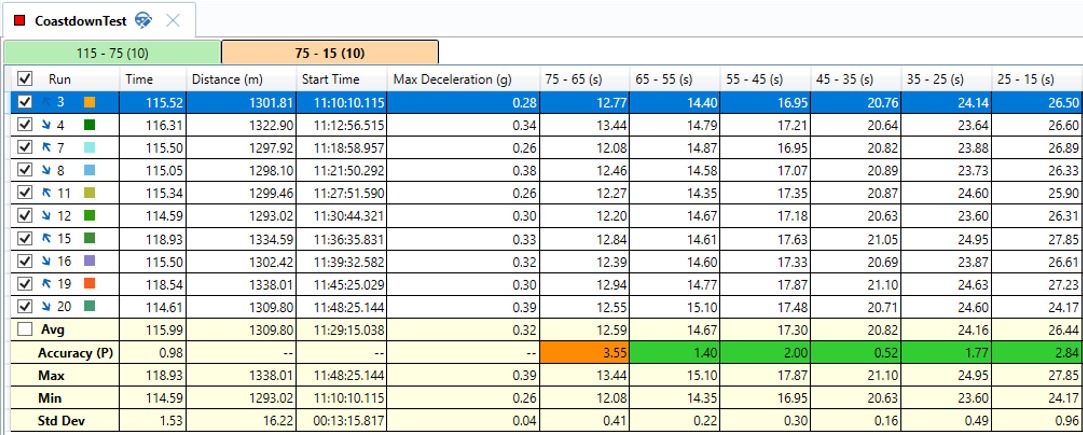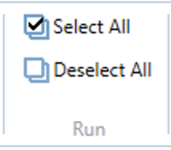WLTP GTR15 Coastdown
Introduction
The ‘WLTP GTR15 Coastdown’ test is a plugin for the VBOX Test Suite software.
The test itself allows the user to complete and analyse a coastdown test to the latest WLTP Coastdown protocol.
Ribbon Bar
The WLTP GTR15 Coastdown test has a tailored 'Test Setup' ribbon bar, from which the test and test area can be configured.

Note: Ribbon bar icons may move/ resize dependent on the Software window size.
Test

Configure
The 'Configure' button displays a pop up window whereby the parameters of the test can be defined.
Report
The 'Report' button creates a report from the current test results. This button is only available when a run or run has been selected from the test results window.
Save Settings
The 'Save Settings' button will save this individual test setup and will appear in the ‘Saved Settings’ area of the ‘Add Test’ window.
This test will also be added to the list of WLTP GTR15 Coastdown tests under the 'Coastdown' icon on the 'Home' tab for easy switching of the current test.
Edit Data
The 'Edit Data' button allows the user to enter session specific data such as driver name, track facility and weather data.
Test Configuration
Selecting the 'Configure' button will display a pop up window where the user can define the parameters of the test. These include the start and end conditions, as well as the pass conditions.
Use the up and down buttons  to the right of the parameters to Expand and Collapse the parameter headings.
to the right of the parameters to Expand and Collapse the parameter headings.

Speed Range Configuration
Start/ End Speed
This parameter denotes the speed at which the test will start and end.
Split Runs
To perform a ‘Split Run’ whereby the coastdown test is split into different speed ranges, the user can press the ‘+’ button to add a new speed range. If speed ranges are set to overlap (i.e 90 – 60, 70 – 40), the accuracy (P) results of the overlapping period will match across each range, calculated based on the average of the coastdown time that overlaps.
Split runs will display within the results area as separate tabs, the colour of the tab is dependent on the number of valid runs within the speed range; red = no runs, orange = 0 –10 runs in each direction, green = >10 runs in each direction.
Breakdown Interval
This allows the user to specify the ∆v speed interval that each run will be broken down into (cannot be 0 km/h).
Trigger
To stop the software reading false coastdowns (i.e. braking into a turn around point), the user can select the ‘Requires Trigger’ option. When this option is ticked, the software will not record a coastdown result unless the trigger is active. Releasing the trigger at any time during a coastdown will invalidate that run.
Accuracy
Statistical Accuracy
The level at which a test will be regarded as ‘Good’. If the run does not meet the user enter accuracy, the accuracy gauge on the dashboard will report 'NOT OK' and the result will be coloured orange in the results table.
Minimum Sets
The minimum number of complete sets (1 set = 1 run in both directions) required before the statistical accuracy will start to calculate.
Mean Calculation Method
This allows the user to specify whether the mean average value should be calculated via the harmonic or arithmetic method.
Deceleration
To stop incorrect coastdown runs (for example braking into a corner) being included in the accuracy calculations, there is an option to highlight runs that have had a longitudinal acceleration greater than a specified value.
Speed Quality
This option allows the user to enter criteria that will quickly identify whether there has been a ‘Speed Jump’ during the coastdown run. If selected, a PASS/FAIL column for the speed quality appears in the Results Table to indicate if the criteria has been met after each run. A gauge is also available for selection on the Dashboard.
Pass Conditions
Completing a test
To start an online test, the user must first select the correct COM port from the ‘Online’ drop down menu in home tab. Once connected to a VBOX, the dashboard will change to show the 'START', 'STOP' and 'RESET' buttons.
Starting, Stopping and Resetting a test
By pressing the 'START' button, the software will add a tab to the Test Results area ready to be populated with results once the start and end criteria have been met. The 'START' button will also change to a 'PAUSE' button, allowing the user to pause the test. To resume the test, simply press the 'RESUME' button.
To finish a test, simply press the 'STOP' button. This will stop all open tests. Once the stop button has been pressed, future results cannot be added to that results tab. Pressing the 'START' button will open up a new results tab.
If, for any reason, a mistake has been made during the test, it is possible to restart the test by pressing the 'RESET' button.
Note: Tests must be bidirectional, if a user performs 2 runs in the same direction the initial results will be overwritten. If the heading deviates during a run the results are discarded.
Test Results Area
The test results area is the area that displays all of the results from the current test. Within this area it is possible to include/exclude results from the chart area, display the average/max/min values and also easily identify any runs which have not met the pass criteria.
Every time a new test is started (via the 'START' button on the dashboard), or a new file is loaded, a new tab will be added to the test results area, allowing the user to switch between separate tests or files and compare runs from each. A session can be removed from the results area by pressing the ‘x’ icon on the tab.
Session Data
By pressing the 'Edit Data' button .jpg?revision=1&size=bestfit&width=60&height=57) next to the name of the file/run or in the ‘Test Setup' ribbon bar, a new window will be displayed whereby the user can add various different pieces of vehicle and test information, such as:-
next to the name of the file/run or in the ‘Test Setup' ribbon bar, a new window will be displayed whereby the user can add various different pieces of vehicle and test information, such as:-
-
Vehicle
- Vehicle Model
- Vehicle Number
- Driver Name
- Mass at Start
- Mass at End
- Rotating Mass
-
Wheels/Tyres
- Tyre ID No
- Tyre Make
- Tyre Dimensions
- Tyre Model
- Tyre Pressures
-
Test
- Test Date
- Time Zone
- Test Track
- Test Facility
- Comments
- Conditions
- Weather
- Temperature
- Atmospheric Pressure
- Wind Speed
When in 'Offline' mode, this information will be saved into the .vbo file meaning that this information will be recalled every time the file is loaded into VBOX Test Suite.
When in 'Online' mode, a newly-created session will be populated with session data from the previous session.
This information will be included in the test report to allow the user to understand which result applies to which tyre.
Note: This data is purely optional and has no effect on the test or test result.
To save time, it is possible for the user to import and export the session information for use in other sessions (the entire range of data is exported not just the visible screen).
Once the session information has been completed, it is possible to export the data to a .vbses file. This file will contain all the session information that can then be imported into the open session information field.
Result Columns

Along the top of the Test results area are some default columns. These columns are:-
- Run – Indicates which run number the results relate to, with run one being the first run completed and the direction of travel of the run. Runs are grouped together to form a set. There is also a selection box that, when ticked, includes that run in the graph and into the Average/Max/Min/Standard Deviation calculations. Once selected, a coloured square will appear to indicate which colour this run is displayed as on the graph. Any runs that do not pass the set conditions will be unticked.
Note: If you are loading a file offline, all valid runs are ticked automatically. - Time – The total time the run has taken.
- Distance – The total distance travelled in that run.
- Start Time – The UTC time at which the test started.
- Max Deceleration – The maximum absolute value of longitudinal deceleration between the start of test and end of test. If the Maximum Deceleration parameter is exceeded, this column will be highlighted deep red and the whole run will be highlighted light red.
- Time breakdown – Time taken in seconds for the run to cover the speed Breakdown Intervals.
- Speed Quality (if speed quality check has been ticked) – A PASS/FAIL indication of whether the Speed Quality criteria has been met. If failed, this column will be highlighted deep red and the whole run will be highlighted light red.
- Notes.
Adding a Note
Notes can be added to the ‘Notes’ column of the results area. This is done by double clicking inside the column for the required run. This will then change that column to a text box and you can enter a note against that run. This note will then be included in the report and the exported .csv file.
Average/Accuracy/Max/Min/Standard Deviation Values
It is possible for the software to automatically calculate the Average/Max/Min/Standard Deviation values of all relevant runs by ticking the selection box next to the relevant run number.
The accuracy figure will report ‘--‘ until the required number of sets have been completed. Once a value can be calculated, the value will be highlighted orange to show that it is outside the required accuracy, or green to show it is below the required accuracy.
Once more than one result has been selected, the average, maximum and minimum values will be displayed, and once more than two results have been selected, the standard deviation of the selected runs will be also be displayed.
Selecting the tick box next to the ‘Avg’ line will add a moving average ‘best fit’ curve to all of the selected runs.
Dashboard
Along with the usual dashboard functionality, the ‘WLTP GTR15 Coastdown’ test has some extra options that can be displayed to the user.
By selecting the 'Add Gauge' button from the dashboard tab, a drop down menu will appear whereby the user can select 'Test' and then the desired parameter to be displayed. On selection, a gauge will be automatically added to the dashboard. Any gauges displaying a result of a test, such as an average or maximum value, will have a 'Result' icon  to the left of the gauge name to indicate that it is either a result of the previous run if viewing live data, or the currently selected run if viewing a saved file.
to the left of the gauge name to indicate that it is either a result of the previous run if viewing live data, or the currently selected run if viewing a saved file.
All Result Column parameters are also available as a gauge.
Showing Test Results on the Dashboard
It is possible to display the test results from the last run completed as a gauge on the dashboard. The current speed range, the accuracy of the speed range, the current total run number and the individual number of runs in each speed range can all be displayed on the dashboard.
.png?revision=1)
An 'OK Runs' gauge can also be added to indicate how many runs have met any specified pass conditions.

Speed Quality
A 'Speed Quality' gauge is available for use when conducting live testing to show the status of the last completed run with regards to the Speed Quality criteria. It will display as a green 'PASS' when the last run has met the criteria and a red 'FAIL' when the criteria has been exceeded.

Creating a Report
VBOX Test Suite allows the user to turn the results table into a custom report whereby the user can easily compare and display the results from their coastdown test.
This report will include all of the previously entered session data, along with a table of results that show the coastdown times in each direction. The average coastdown times for each speed interval will then be displayed for both direction 1 and direction 2.
If the user manually deselects a valid run, this will be displayed in the report as ‘Off’ under the ‘Run-Use’ column.
The user can then choose to print or save this report. A sample of this report* can be seen below:-
.png?revision=1)
.png?revision=1)
* The data here is simulated data and is in no way a reflection of the indicated manufacturer's coastdown ability.





